Your Guide to AI Music Video Makers
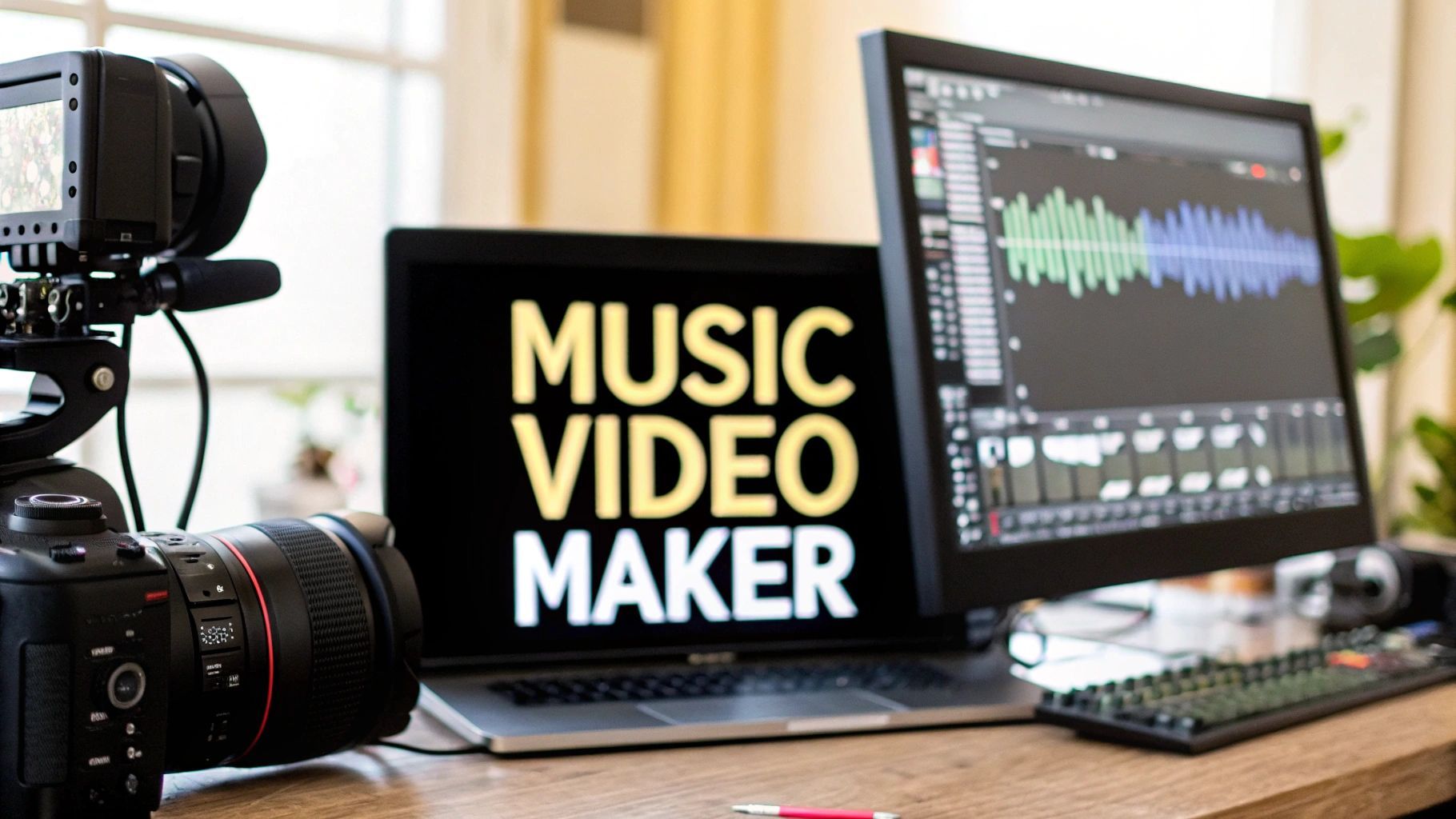


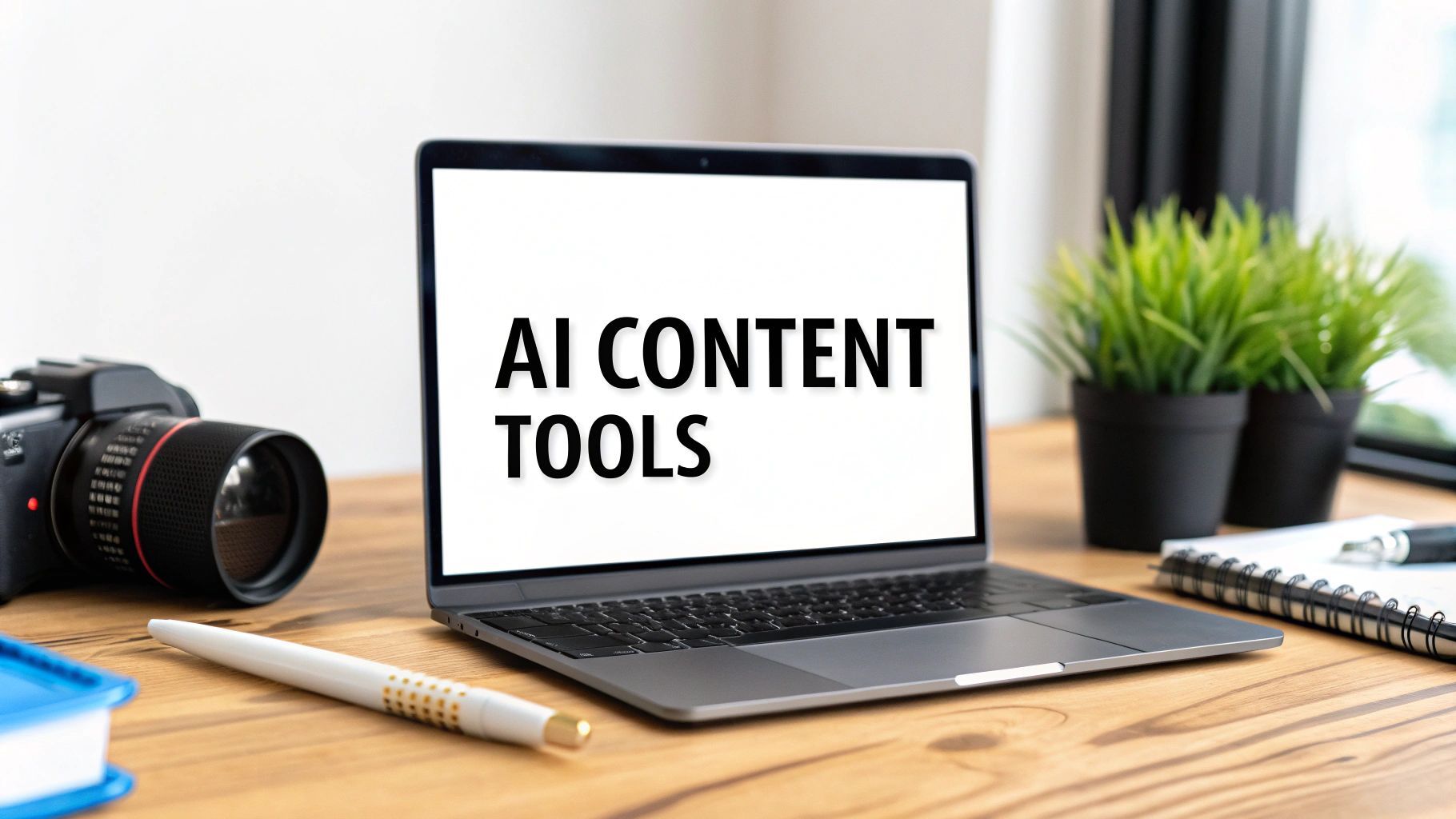
Discover the best AI tools for content creation. This guide helps you choose, use, and master AI to boost your creativity and efficiency.
Let’s be honest, staring at a blank page is the worst. It’s a creative black hole. But imagine having a co-pilot sitting next to you, ready to spitball ideas, hammer out a first draft, or even sketch out a design. That’s what using AI tools for content creation feels like. They’re not here to replace you; they’re here to amplify your own genius and get you from a fuzzy idea to a finished piece in record time.
Welcome to the new age of making stuff online. Artificial intelligence isn't some sci-fi concept anymore—it's a real, practical part of a modern creator's toolkit. This isn't about robots coming for your job. Far from it. It's about boosting your unique, human creativity.
Think of these tools as the ultimate creative assistant. They tackle the grunt work—the repetitive, soul-crushing tasks that drain your energy and lead straight to burnout. This frees you up to do what you do best: the big-picture strategy, the out-of-the-box thinking, and the original ideas that a machine could never dream up. It’s the perfect team-up of human ingenuity and machine muscle.
The shift to AI-assisted creation is, frankly, a massive shake-up. Things that used to take days of grinding—like drafting a solid blog post or whipping up a batch of social media graphics—can now be knocked out in a sliver of the time. This kind of speed is a game-changer for everyone, from one-person-shows to huge marketing departments.
And the market is exploding to prove it. The AI-powered content creation space is on a rocket ship, projected to hit $3.53 billion by 2025 and an eye-watering $7.74 billion by 2029. This isn't just some flash-in-the-pan trend; it's a deep, fundamental change in the very fabric of content production. You can dig into the numbers yourself with recent market analyses.
The perks go way beyond just moving faster. Weaving AI tools into your workflow can help you:
Smash Through Writer’s Block: Feeling stuck? Instantly get outlines, headlines, and fresh topic ideas. Boost Your Quality: Let an AI polish your grammar, lock in a consistent tone, and even suggest punchier ways to say something. Scale Like a Pro: Churn out way more top-notch content without having to beg for a bigger budget or a larger team.
At the end of the day, AI-powered creation is about achieving more with what you already have. It’s about giving you the power to bring your biggest, boldest ideas to life without the old-school limits of time, money, or a sudden lack of inspiration.
This guide is your roadmap to this exciting new world. We'll break down the different kinds of tools, show you how to pick the right ones for your mission, and walk you through building a seamless, integrated system. Get ready to supercharge your process, multiply your output, and get your time back for the part that actually matters—your creativity.

Thinking all AI tools for content creation are the same is like saying a hammer and a screwdriver do the same job. Sure, they both help build stuff, but you’d look pretty silly trying to hammer in a screw. It just doesn't work.
The same logic applies here. The AI content world is a massive, specialized workshop, absolutely packed with a unique gadget for every creative task you can dream up. This isn't a one-size-fits-all game; to build a killer creative toolkit, you first need to know what tools are in the box.
Let's take a quick tour through the main aisles of this digital workshop.
This is the big one—the category that usually comes to mind first. These tools are your tireless writing partners, ready to jump in on anything from a quick, punchy social media caption to a comprehensive blog post. Think of them as a brainstorming buddy and a first-draft machine all in one. You feed them a prompt, and they spin up the text.
And this space is absolutely exploding. The global market for this kind of AI in content is projected to leap from $14.8 billion in 2024 to a staggering $80.12 billion by 2030. That’s not just growth; it’s a rocket ship, showing just how indispensable these writing tools are becoming for creators everywhere.
Here’s where they really shine:
Wiping Out Writer’s Block: They're perfect for generating outlines and first drafts to get you past that scary blank page. Social Media Wizardry: They can whip up clever, engaging posts perfectly suited for different platforms. Product Description Power-Ups: Need compelling e-commerce copy that actually sells? Done.
Pro Tip: The real magic is in your prompt. Don't just ask for "an article about marketing." Get specific! Try something like: "Write a 500-word blog post with a witty, conversational voice. It should cover three unconventional marketing tactics for a small, independent coffee shop." Specificity is your secret weapon.
Next, let's meet the visual artists of the AI world. These incredible tools take your simple text descriptions and morph them into stunning, completely original images. You can conjure up anything you can imagine, from a "photorealistic portrait of a cyberpunk astronaut drinking coffee" to a "whimsical watercolor of a cat riding a bicycle on the moon."
The creative doors this opens are mind-boggling. You can produce custom visuals for blog headers, social media, or ad campaigns without needing a graphic design degree or a small fortune for stock photos. To get a feel for the top players, check out our guide on the best AI image generators.
Now, this is where things get really interesting. The power of AI goes way beyond static words and pictures. A whole new class of tools is making video and audio production easier and more accessible than ever before.
These platforms are becoming multi-talented production studios, handling tasks that once required a whole team.
Text-to-Video: Imagine turning a blog post or script into a full video, complete with stock footage, music, and subtitles—automatically. AI Voiceovers: Need a narrator? These tools can turn your text into realistic, human-sounding audio in countless languages and accents. AI Music Composers: Generate royalty-free background music that perfectly matches the vibe of your content. Smart Video Editors: These can automatically snip out awkward silences, add captions, or even dice up long videos into short, shareable clips.
Some of the most exciting developments involve blending different types of AI. For instance, platforms are now starting to integrate language models directly into videos to create interactive experiences. To see this in action, take a look at Mindstamp's ChatGPT integration for video conversational intelligence. This is a peek into a future where your audience doesn't just watch your content—they have a conversation with it.
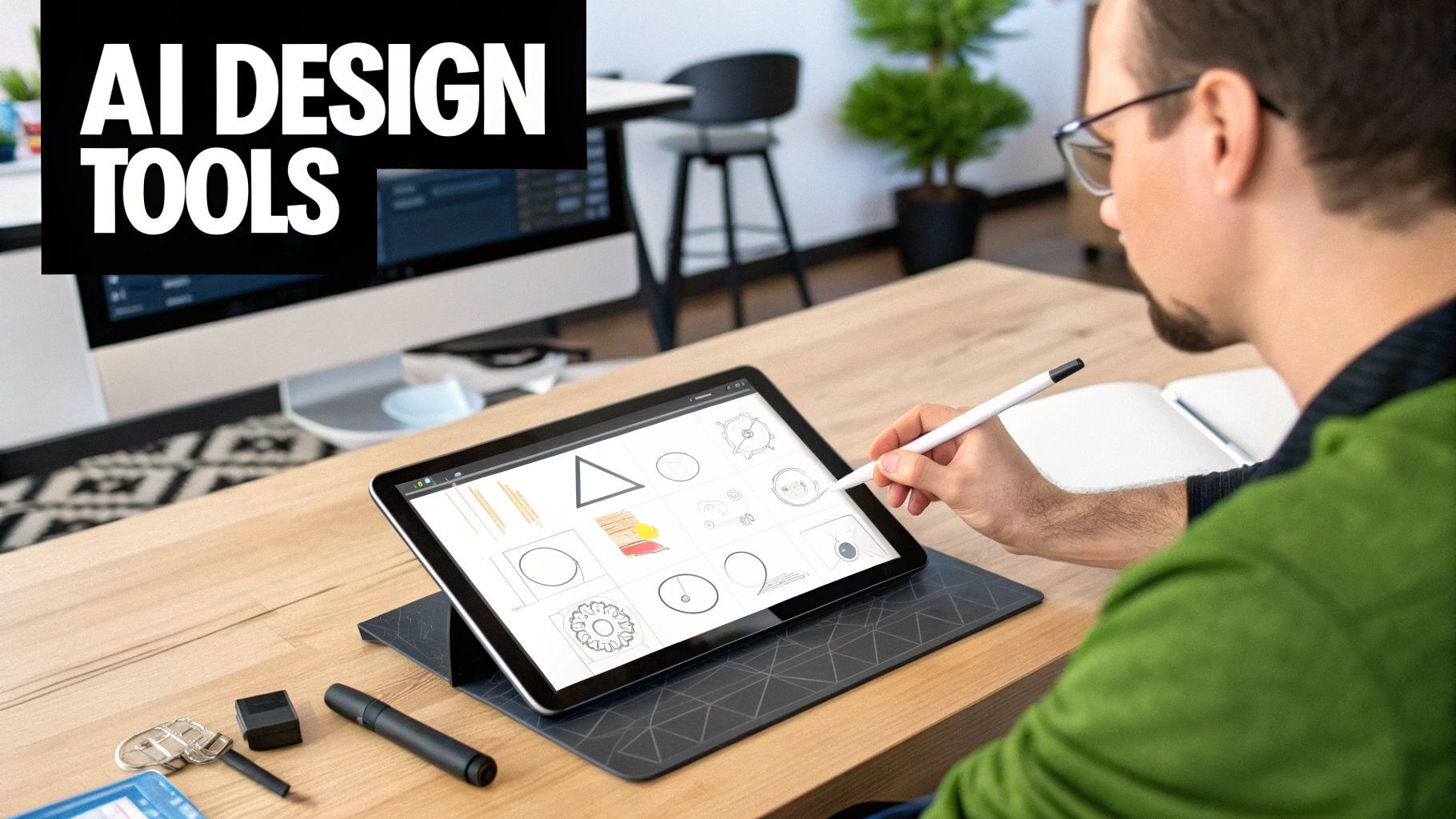
Let's get one thing straight: weaving AI into your creative process isn't about chasing the latest shiny object. It’s about fundamentally rewiring how you work, transforming the daily grind into a well-oiled, intelligent machine. This is where you swap frustrating creative bottlenecks for a wide-open productivity superhighway.
Think of it like this: instead of laying every single brick for a house by hand, AI hands you entire, pre-fabricated walls. You’re still the architect. You call the shots on the blueprint, the design, and all the final touches that make it unique. But the back-breaking labor? That gets done in a tiny fraction of the time. This is the secret weapon setting today’s creators miles apart from the competition.
The first thing you'll notice is the sheer speed. It’s almost jarring. A blog post that used to devour hours of your day for research, outlining, and agonizing over the first draft can now be knocked out in a shockingly short amount of time. This isn't sorcery; it's just smart delegation.
With AI tools for content creation, you can finally offload the most tedious parts of your job. Need five different outlines for a topic? You’ll have them in minutes. A solid first draft? Done by the time you finish your coffee. A dozen social media hooks? Instantly. You're freed from the muck to focus on what really matters—high-level strategy, creative direction, and adding that human polish.
And this newfound efficiency isn't just for writing. It bleeds into every part of your business, like when you use AI in B2B lead generation to find new opportunities.
Every creator knows the cold dread of staring at a blank page. It’s paralyzing. An AI co-pilot, however, is your secret weapon, acting as a bottomless well of inspiration that makes writer’s block a relic of the past.
Feed it a simple concept, and in return, you get a flood of ideas, unexpected angles, and unique perspectives you’d likely never have stumbled upon yourself. It's like having a 24/7 brainstorming partner who’s always caffeinated and never runs out of killer ideas.
This constant creative fuel keeps your momentum sky-high. You’re no longer stuck waiting for a lightning bolt of inspiration to strike—you can summon one whenever you need it, keeping your content calendar packed and your audience hooked.
Speed is fantastic, but not if quality takes a nosedive. The beauty of an AI-assisted workflow is that you get to have your cake and eat it, too. By setting up specific brand voice parameters and style guides, you can make sure every piece of content—from a quick tweet to an in-depth white paper—sounds consistently like you.
This applies across all media. When you're generating audio, for example, maintaining a specific vocal tone is everything. You can really dive into the weeds of this by learning how to find the perfect AI voice actor to match your brand's unique personality. Plus, these tools are brilliant at catching those pesky grammar mistakes, awkward sentences, and tiny inconsistencies that your human eyes would miss after hours of staring at a screen.
This might be the biggest game-changer of all: the power to scale your content production without having to scale your team or your budget. A single creator or a small business can now churn out the volume and variety of content that was once the exclusive domain of giant corporations with massive marketing departments. It's the ultimate democratization of content.
The financial upside is impossible to ignore. In the North American market alone, AI-powered content creation tools pulled in revenues of around $859 million in 2024. That number is projected to explode to nearly $3.85 billion by 2033, signaling a massive shift in where businesses are putting their money. By getting on board, you're not just saving time—you're making a savvy financial move that sets you up for explosive growth.
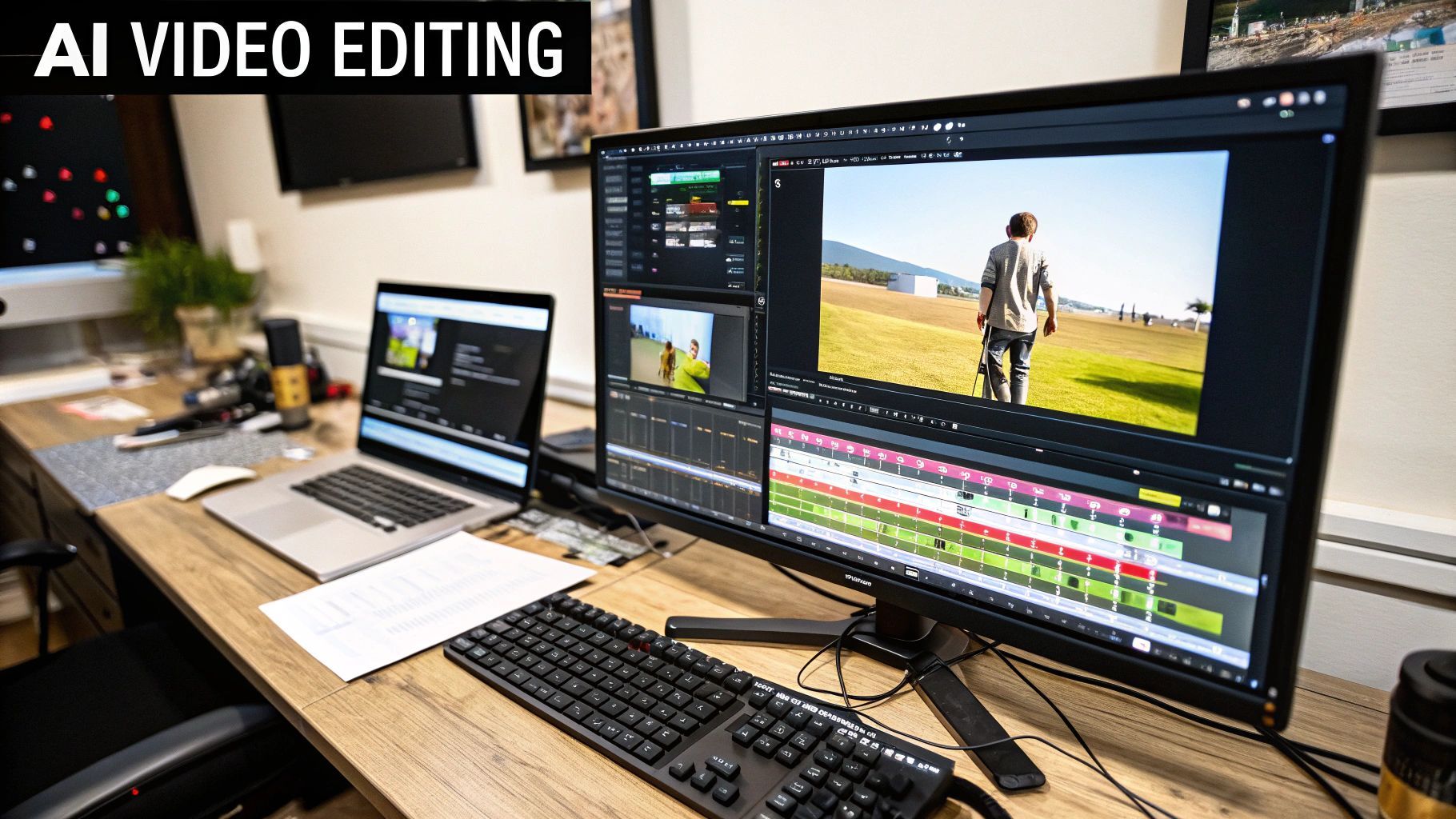
It feels like a new AI tool pops up every hour, doesn't it? Trying to dive in can feel like grabbing a specific jellybean from one of those giant, spinning candy machines. It’s a lot. And frankly, a little dizzying.
Here’s the thing: picking the right AI tools for content creation isn't about finding the one "best" tool to rule them all. It's about finding the best tool for your specific mission.
Choosing blindly is just a fast track to a drained bank account and a desktop cluttered with useless apps. So let's forget that. Instead, we'll build a smart, practical way to make a choice you won't regret in three months. This way, you put your time and money into an AI toolkit that actually pulls its weight.
Before you even think about looking at a feature list or a flashy demo, ask yourself one brutally honest question: "What am I actually trying to make?" The most amazing AI for a novelist is completely useless for someone trying to crank out TikToks. Get specific.
Are you trying to:
Write long-form articles? Then you need a text generator with serious research and outlining chops.Design social media graphics? An AI image generator with style presets and aspect ratio controls is your new best friend.Produce short promotional videos? Look for text-to-video or image-to-video tools that make editing feel like a game, not a chore.Create original music? That’s a whole different beast. You'll need a specialized AI music generator, which we explore in our guide on AI tools for musicians.
Nailing down your main goal is the most important first step. It instantly cuts the field of thousands of potential tools down to a manageable handful of real contenders.
A tool can have all the power in the world, but if using it feels like solving a Rubik's Cube in the dark, you're never going to open it. A clunky, confusing interface is where productivity goes to die. With more than 75% of marketers now using AI, you can bet they aren't sticking with the ones that are a pain to operate.
The best AI tool is the one you'll actually use consistently. Look for a clean, intuitive dashboard and a logical workflow. If you can't figure out the basics within the first five minutes of a free trial, that's a massive red flag.
Okay, so you've found a few tools that fit your goals and don't make you want to throw your computer out the window. Now it’s time to get critical. Not all AI output is created equal. During any free trial, you need to put these core factors under the microscope.
Factor to Test What to Look For Output Quality Does the text sound natural or like a robot wrote it? Are the images high-res and actually relevant? Push the tool with complex prompts. See if it can handle nuance or if it just spits out generic mush. Integration Power How well does it play with others? Does it connect to the software you already live in, like Google Docs, WordPress, or your social media scheduler? Smooth integrations are a massive time-saver. Customization & Control Can you actually steer the ship? Look for options to control tone of voice, artistic style, or editing details. The more control you have, the less your content will look and sound like everyone else's. Speed & Reliability How fast does it generate your content? More importantly, does the platform get sluggish or crash when you need it most? You need a tool that can keep up with a professional workflow.
Your mission is to find that perfect balance between powerful features and genuine usability. A tool that shines in these four areas is probably a keeper. Don't just get wowed by a slick marketing video; put the tool through its paces with your real work. That hands-on testing is the only way to know if you're choosing a true creative partner.
Alright, enough with the theory—let's see these tools in action. The real magic happens when you stop thinking about AI tools as individual gadgets and start building a connected, integrated system. This is how you transform AI tools for content creation from handy little helpers into a full-blown, high-octane production crew.
Think of it like a well-rehearsed orchestra. Each instrument (or AI tool) knows exactly when to come in, playing its part to create a beautiful symphony of content.
Imagine you're launching a marketing campaign. Instead of hopping from one task to another, you can build a seamless assembly line. This connected approach doesn't just save a wild amount of time; it ensures every single piece of content, from a blog post to a social media video, feels consistent and perfectly on-brand.
It’s all about choosing your tools wisely, weaving them into your daily operations, and constantly tweaking your process until it hums.
Let's walk through a real-world example to see how this plays out. Your mission, should you choose to accept it, is to create a multi-channel campaign promoting a new eco-friendly coffee cup. Here’s how your AI-powered workflow might look.
Stage 1: The Spark of an Idea Your journey starts not with a blank page, but with an AI idea generator. You feed it a simple prompt: "marketing ideas for a new reusable coffee cup." In seconds, you're flooded with potential blog topics, social media angles, and video concepts. You spot a winner: "The Ultimate Guide to a Sustainable Morning Routine."
Stage 2: Drafting and Polishing the Core Content With your topic locked in, you fire up your AI writing assistant. You give it a detailed prompt—the title, your target audience (eco-conscious millennials), and a request for a friendly, encouraging tone. Just like that, you have a solid first draft of your blog post.
But a draft is just a draft. Next, you run it through an AI-powered SEO tool. It chews on the text, suggests relevant keywords to sprinkle in, and recommends a few structural tweaks to help it climb the search rankings. After all, creating great content is only half the battle; people need to find it. This is where understanding content SEO best practices becomes crucial.
Stage 3: Bringing the Content to Life Visually Now for the fun part. You use an AI image generator to create a custom hero image for your blog post. You type in, "a minimalist photo of a person enjoying coffee from a stylish, reusable cup in a sunlit kitchen," and boom—a perfect image appears. You also whip up a few smaller graphics to break up the text and keep readers engaged.
This is where you really see the efficiency gains. Sticking to a structured AI process can dramatically speed things up.
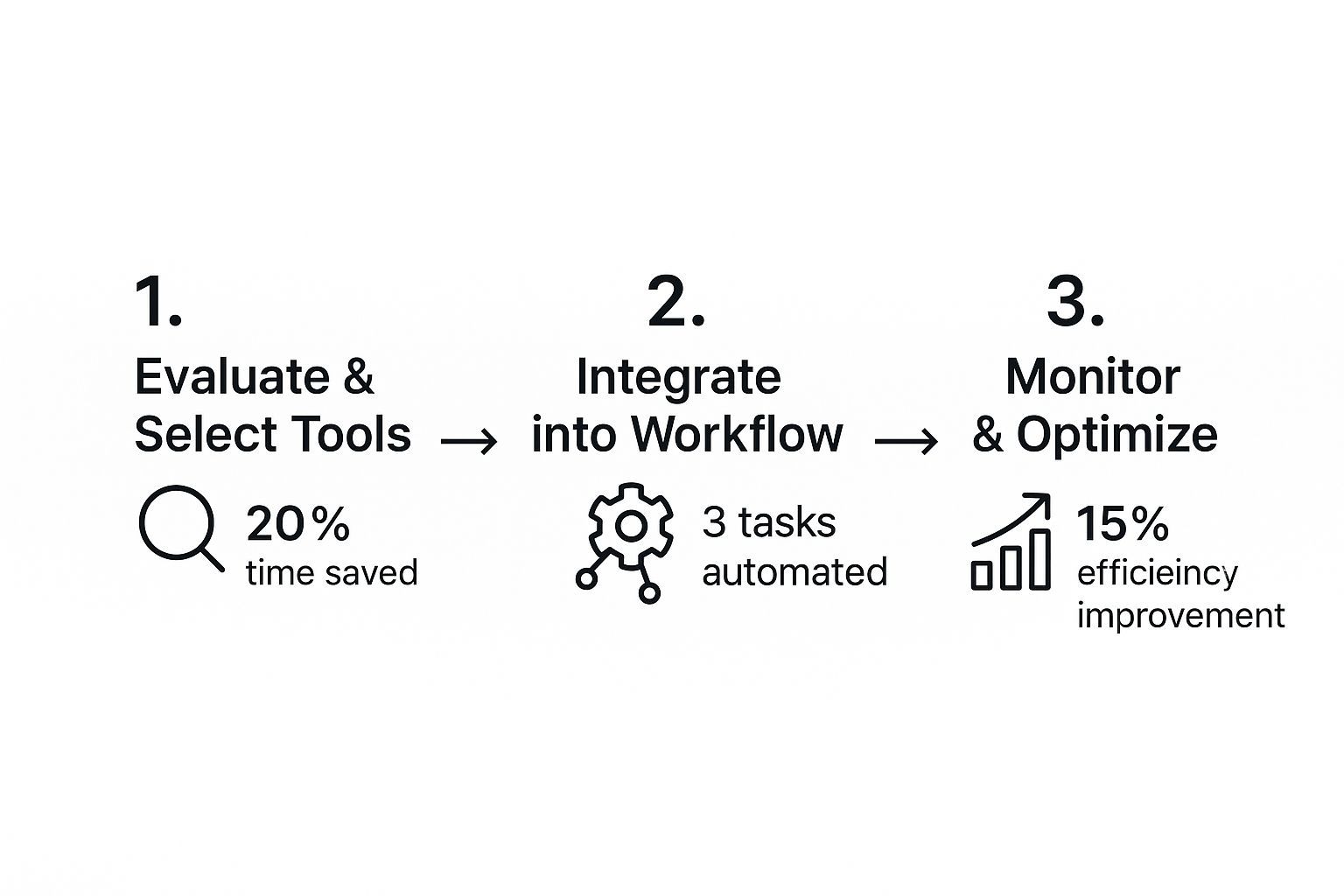
As you can see, a systematic approach doesn't just feel better—it delivers measurable improvements in time and output.
The blog post is live, but your AI workflow is far from finished. It's time to squeeze every last drop of value out of that core piece of content. This means repurposing it into a whole bunch of different formats to catch your audience wherever they hang out.
To see how this works in practice, let's map out the entire campaign from start to finish.
Integrated AI Campaign Workflow Example
Campaign Stage AI Tool Type Task Executed Ideation Idea Generator Brainstorms topics for a "reusable coffee cup" campaign. Drafting Writing Assistant Creates a first draft of a blog post on sustainable mornings. Optimization SEO Tool Analyzes the draft for keywords and suggests SEO improvements. Visuals Image Generator Creates a hero image and supporting graphics for the blog. Video Text-to-Video Tool Converts blog highlights into a 60-second promotional video. Social Media Social Media Assistant Generates 5 tweets and a LinkedIn post from the blog URL. Audio Text-to-Speech Tool Creates an audio summary of the post for a mini-podcast.
This table lays it all out. A single idea branches out into a comprehensive, multi-channel campaign, all powered by a smart, connected workflow.
By following this process, you’ve turned one idea into a blog post, multiple custom images, a slick promo video, and a whole batch of social media updates. That’s not just working faster; it's working smarter. You're getting the most bang for your buck by transforming one asset into a full-fledged marketing blitz, saving you from starting from scratch every single time. Now that's what I call efficiency.
So, you're looking at all these AI tools for content creation and your head is probably spinning. It’s a brand-new playground, and it's totally normal to have a ton of questions. Let's cut through the noise and tackle the big ones head-on.
Think of this as your personal FAQ session with someone who's been in the trenches. We'll bust some myths and give you the straight scoop so you can start creating with confidence.
This is the elephant in the room, isn't it? The short answer: nope. Using AI won't automatically send you to the bottom of Google's rankings. Search engines have one main job—to serve up helpful, high-quality content that answers a human's question. They honestly don't care if a robot helped you write it.
The real danger isn't the AI itself, but how you wield it. If you're just hitting "generate" and slapping the raw, unedited text onto your blog, you're basically creating sophisticated spam. And yeah, that will get you penalized.
But when you treat AI as your creative partner—for brainstorming ideas, structuring an outline, or getting a first draft down—and then you layer on your own expertise, voice, and fact-checking? That’s a whole different ballgame. You can produce better content, faster and more consistently. That's exactly what search engines reward.
The Bottom Line: AI isn't the enemy; bad, lazy content is. As long as you're focused on creating something genuinely valuable for your audience, your SEO will be more than okay.
Highly doubtful. Think of AI as the world's most efficient and knowledgeable intern. It can fetch data, organize your thoughts, and handle the grunt work at lightning speed. But you're still the creative director. You’re the one flying the plane.
AI is brilliant at crunching data and spotting patterns, but it has zero life experience. It's never felt the thrill of a successful launch or the sting of a failed campaign. It can't feel empathy, tell a truly original story, or understand the subtle nuances of your brand's personality.
The magic happens when you pair AI’s raw power with a human’s strategic mind and creative soul.
Your Job: Set the vision, inject your unique voice, share authentic stories, and be the ultimate gatekeeper of quality. AI’s Job: Do the heavy lifting—the research, the first draft, the data sifting, and spitting out variations to get your creative juices flowing.
This isn’t a replacement; it’s an upgrade. AI doesn't make the creator obsolete; it makes them unstoppable.
Ah, the dreaded "vanilla" content. The secret to avoiding it comes down to two things: your prompts and your process. Garbage in, garbage out. If you give a generic prompt, you'll get a generic result.
Stop asking for "a blog post about marketing." That's a recipe for boredom.
Instead, try something like this: "Write a witty, 500-word blog post. The tone should be like Ann Handley—smart but approachable. Cover three low-cost social media tactics for brand-new, independent coffee shops trying to stand out in a crowded city." See the difference? Rich, detailed context is your superpower.
And never, ever treat the AI's output as the finished product. It's a starting point. A lump of clay. Your job is to roll up your sleeves, edit mercilessly, weave in your own anecdotes, double-check every fact, and polish it until it shines with your personality. That one-two punch of a great prompt and a thorough human touch is how you create content that truly stands out.
Ready to see how an integrated AI toolkit can completely change your creative game? SendFame lets you generate incredible videos, custom-fit music, and unique images in just a few seconds. Say goodbye to the blank page and hello to your next great creation. Explore what's possible at https://sendfame.com.
Create Epic
SendFame